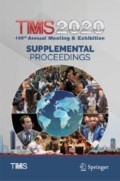Abstract
Dislocation dynamics simulations is an inherently multi-scale computational methodology in materials deformation modeling . The authors address an important topic in such modeling which is the treatment of boundary conditions on the computational domain. Specifically, the effect of traction-free surfaces on the plasticity, i.e. the motion of dislocations and ensuing plastic flow, is treated here. To solve this numerical problem, the surface in question is meshed with elements each representing a dislocation loop. The boundary condition is enforced by solving a system of equations at each time step for the Burgers vectors of such loops. This is a collocation method with collocation points on the surface, and therefore, the higher the areal density of the points, the better the numerical outcome. Modeling results have been verified and are presented herein.
Access this chapter
Tax calculation will be finalised at checkout
Purchases are for personal use only
References
Hull D, Bacon DJ (2011) Introduction to dislocations, Butterworth-Heinemann
Yoffe EH (1961) A dislocation at a free surface. Phil Mag 6(69):1147–1155
Groves PP, Bacon DJ (1970) The dislocation in a semi-infinite isotropic medium. Fundam Asp Disloc Theory 1(317):35–45
Groves PP, Bacon DJ (1970) The dislocation loop near a free surface. Phil Mag 22(175):83–91
Maurissen Y, Capella L (1974) Stress field of a dislocation segment parallel to a free surface. Phil Mag 29(5):1227–1229
Maurissen Y, Capella L (1974) Stress field of a dislocation segment perpendicular to a free surface. Phil Mag 30(3):679–683
Comninou M, Dundurs J (1975) The angular dislocation in a half space. J Elast 5(3–4):203–216
Gosling TJ, Willis JR (1994) A line-integral representation for the stresses due to an arbitrary dislocation in an isotropic half-space. J Mech Phys Solids 42(8):1199–1221
Lothe J, Indenbom VL, Chamrov VA (1982) Elastic field and self-force of dislocations emerging at the free surfaces of an anisotropic halfspace. Physica Status Solidi (B) 111(2):671–677
Kubin LP, Canova G, Condat M, Devincre B, Pontikis V, Brechet Y (1992) Dislocation microstructures and plastic flow: a 3D simulation. Solid State Phenom 23–24:455–472
Canova GR, Fivel MC (1999) Developing rigorous boundary conditions to simulations of discrete dislocation dynamics. Modell Simul Mater Sci Eng 7:753–768
Hartmaier A, Fivel MC, Canova GR, Gumbsch P (1999) Image stresses in a free-standing thin film. Modell Simul Mater Sci Eng 7(5):781–793
El-Azab A (2000) The boundary value problem of dislocation dynamics. Modell Simul Mater Sci Eng 8(1):37–54
Deng J, El-Azab A, Larson BC (2008) On the elastic boundary value problem of dislocations in bounded crystals. Phil Mag 88(30–32):3527–3548
Khraishi TA, Zbib HM (2002) Free-surface effects in 3D dislocation dynamics: formulation and modeling. J Eng Mater Technol 124(3):342
Yan L, Khraishi TA, Shen Y-L, Horstemeyer MF (2004) A distributed-dislocation method for treating free-surface image stresses in three-dimensional dislocation dynamics simulations. Modell Simul Mater Sci Eng 12(4)
Khraishi TA, Zbib HM (2001) Dislocation dynamics simulations of the interaction between a short rigid fiber and a glide circular dislocation pile-up. Comput Mater Sci 24:310–322
Devincre B (1995) Three dimensional stress field expressions for straight dislocation segments. Pergamon 93(11):875–878
Chapra SC, Canale RP (2002) Numerical methods for engineers: with software and programming applications. McGraw-Hill
Acknowledgements
This work was supported in part by Sandia National Laboratories (SNL) which is operated by NTESS for the US Department of Energy.
Author information
Authors and Affiliations
Corresponding author
Editor information
Editors and Affiliations
Rights and permissions
Copyright information
© 2020 The Minerals, Metals & Materials Society
About this paper
Cite this paper
Siddique, A.B., Khraishi, T. (2020). An Improved Collocation Method to Treat Traction-Free Surfaces in Dislocation Dynamics Simulations. In: TMS 2020 149th Annual Meeting & Exhibition Supplemental Proceedings. The Minerals, Metals & Materials Series. Springer, Cham. https://doi.org/10.1007/978-3-030-36296-6_77
Download citation
DOI: https://doi.org/10.1007/978-3-030-36296-6_77
Published:
Publisher Name: Springer, Cham
Print ISBN: 978-3-030-36295-9
Online ISBN: 978-3-030-36296-6
eBook Packages: Chemistry and Materials ScienceChemistry and Material Science (R0)

